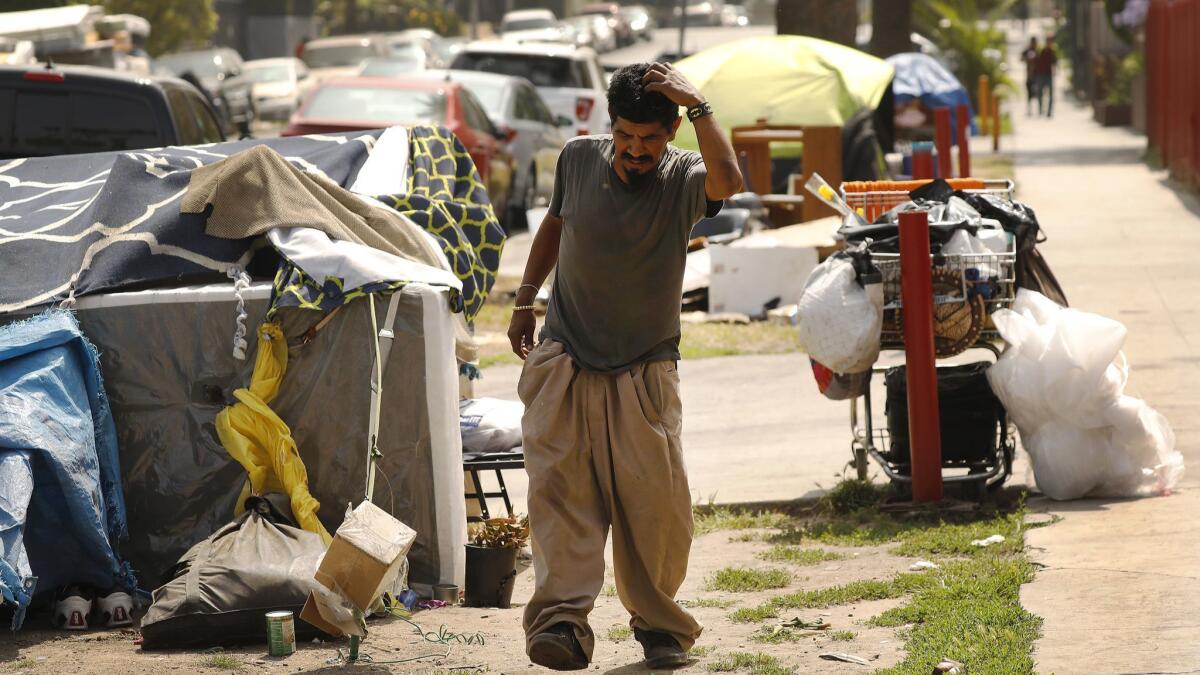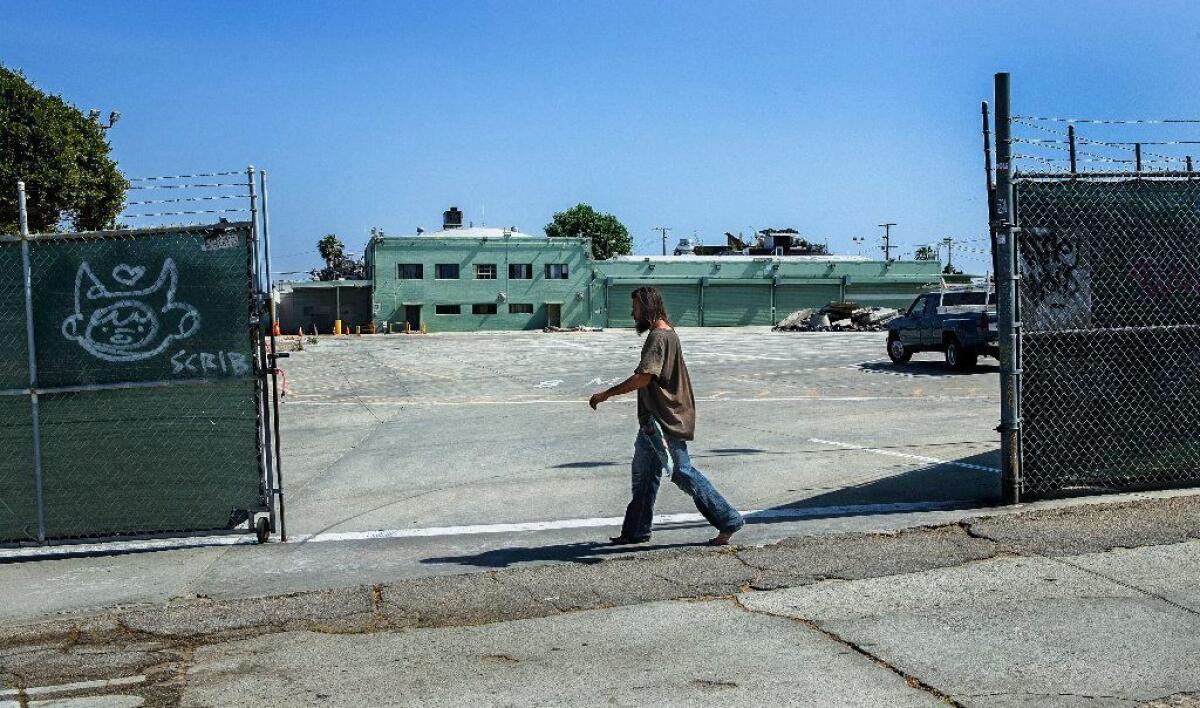Even if California spends millions more on homelessness, here’s why few will notice

- Share via
In a few weeks, Los Angeles is expected to report an increase in homelessness — the latest in a string of similarly dire reports from cities and counties across California.
The pressure is on to find ways to get more people indoors quickly and to prevent others from becoming homeless in the first place. To that end, Gov. Gavin Newsom this week announced the leaders of a new statewide homelessness task force.
Newsom also recently sent California lawmakers a revised budget that would provide cities and counties with a one-time infusion of $650 million to open emergency shelters, provide rental assistance to struggling tenants and underwrite the construction of permanent housing, among other uses. Of that funding, $275 million of it would go directly to 13 of California’s largest cities, most of it to Los Angeles.
But if the past is any indication of the future, the millions of dollars — even with a task force to coordinate solutions — probably wouldn’t make much of an immediate dent in the status quo of homelessness.
Last year, for example, former Gov. Jerry Brown signed a bill that provided a similar one-time injection of $500 million under to fight the explosion of homelessness under the Homeless Emergency Aid Program. The state’s 11 largest cities received $150 million of that and their mayors — with L.A.’s Mayor Eric Garcetti front and center — were the ones lobbying the Legislature for it.
For San Jose, $4 million of the $11.3 million the city received was spent on rental subsidies to 400 households. In Sacramento, which received about $6 million, the city put a sizable portion toward a new, 100-bed homeless shelter. Anaheim was able to put the money toward a shelter for 224 people. The funding proved particularly useful for this Orange County city, which was forced to provide 325 shelter beds after a group of homeless residents sued.
Yet, homelessness is still on the rise.
Some state-funded projects and programs have been slow to show results by the standards of a frustrated public. And housing in California has become so expensive that it has been hard to feel the impact of the spending because, in many places, people are falling into homelessness as fast as people on the streets can be housed.
In Los Angeles, a recent county report found that 27,000 homeless people had been placed into permanent housing in 18 months. But a renter needs to make $47.52 per hour, which is more than triple the minimum wage, to pay the median monthly rent of $2,471, according to another report by the California Housing Partnership.
In Alameda County, where Newsom launched his task force, the most recent point-in-time count revealed a 43% jump in homelessness since 2017. EveryOne Home, the organization that conducted the count, says that every year, about 1,500 people enter permanent housing in the county, while nearly 3,000 people also become homeless for the first time.
Cities are expected to commit at least half their Homeless Emergency Aid Program, or HEAP, funding to projects and programs by the end of the year, and spend it all by June 30, 2021.
A coalition of big-city mayors issued a report in March that found 53% of the funds had been committed to “capital improvements.” Across the state, cities and counties proposed spending 34% of the $500 million on such projects, including new shelters, according to the California Homeless Coordinating Finance Council, which oversees the program.
Another 38% went to services, while 13% has gone to rental assistance or subsidies. But state officials couldn’t say yet exactly how the money had been spent at the local level. That’s partly because they just finished distributing it in April.
State lawmakers also deliberately created the block-grant program with few strings attached. All cities had to do was declare a shelter emergency and demonstrate “a local collaborative process was conducted prior to application submission.”
Many cities and counties had existing strategic plans to fight homelessness, but didn’t have the money to fully implement them. So when the HEAP money was announced, it was easy to use. Many did what Sacramento did, where officials covered spending holes on capital improvement projects to finish them sooner.
Mayors welcomed the freedom.
“I think it’s critically important that the state have high standards and accountability for outcomes,” said San Jose Mayor Sam Liccardo, “but that doesn’t suggest a need to micromanage how the dollars are used.”
The lack of a coordinated plan has frustrated some advocates for the homeless, though. They would’ve liked the state to tie the money to programs and ideas that have a proven track record of working.
“If the state is going to do anything on homelessness, we need to drive best practices,” said Christopher Martin, a legislative advocate at Housing California. “We don’t know what that money went for, and that’s really concerning because we’re giving money to jurisdictions and just trusting they’re doing the right thing.”
Sacramento Mayor Darrell Steinberg, who chairs Newsom’s task force with Los Angeles County Supervisor Mark Ridley-Thomas, said most experts agree that more housing coupled with intensive outreach is the only solution to homelessness. But the HEAP money has been a useful tool in finding shorter-term fixes.
“There has not been nearly enough emphasis, in my opinion, statewide — until now — on actually getting people off the streets,” Steinberg said. “We can’t just wait for all the housing solutions to come to fruition before we get people off the streets.”

As the largest city in California, Los Angeles received the largest share of the HEAP funding, with $85 million going into its coffers. The city hasn’t been able to spend the money as fast as it came in, though.
In April 2018, Garcetti committed to building temporary homeless shelters in each of L.A.’s 15 council districts. At the time, $30 million was committed from the city’s coffers to his “A Bridge Home” program and L.A. was able to augment that with about $50 million from the state, so far.
But through March of this year, just $2.8 million — or about 2.7% — has actually been spent, according to city documents. The challenges of building in Los Angeles along with opposition from residents in some neighborhoods, including Venice, have slowed the process.
Only three shelters have opened so far — one recently. The city is seeking to use some of the state funds to help cover higher-than-expected construction costs and pay to run several shelters, which weren’t totally covered by Measure H, the 2017 sales tax hike. The city has also set aside $20 million of the state money for projects on skid row.
Despite the slow rollout of HEAP money, which the city received in mid-November 2018, Deputy Mayor Christina Miller said that more than half had been obligated nine months before the deadline to do so. She said that while she and the mayor are impatient to see results, the fact that the city had a preexisting plan helped the city figure out what to do with the money fast.
“When the applications came down the pipe, no one was sitting around wondering what to do,” she said. “The ability for this grant to be as flexible as it was was a real game changer. We never had flexibility like this from [the] state.”
More to Read
Sign up for Essential California
The most important California stories and recommendations in your inbox every morning.
You may occasionally receive promotional content from the Los Angeles Times.














